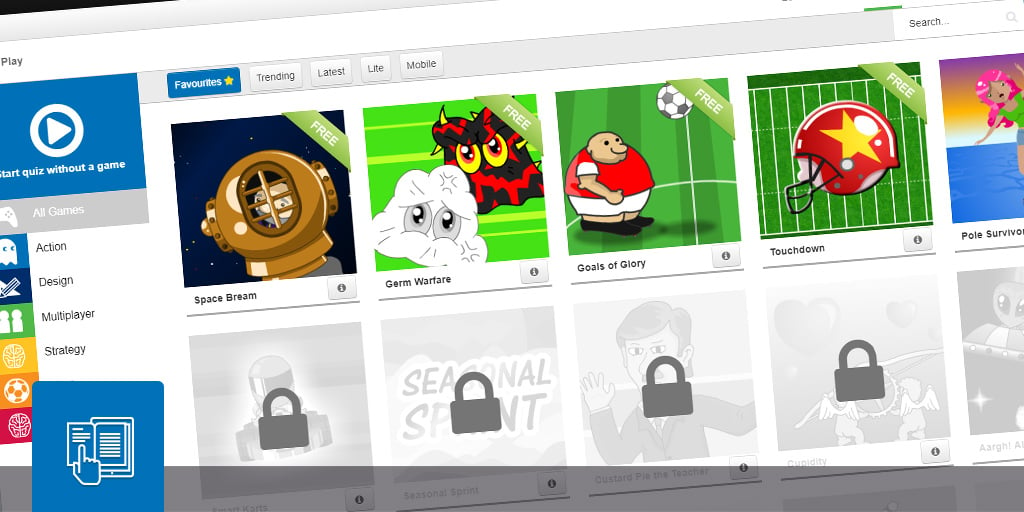Gamification has been used for a number of years across different industry sectors. The term, first coined in 2002, and later used in relation to education technology around 2008, is now commonly used by businesses, in consumer markets and the education sector to offer a more engaging way to interact with a product/service, concept or to complete a task.
Gamification can simply be defined as “an approach that uses game features in non-game settings”. Game features include elements such as point and reward systems that act as incentives for people to participate. Recent examples in consumer markets include customer loyalty schemes, health insurance that rewards you for keeping fit, and you can even earn points for the way you drive from Toyota in Japan.
What is gamification of learning?
The gamification of learning is an approach used to engage students through the use of video game and game elements in educational environments, such as the class room, but has now been extended to home learning through homework management software that uses game play.
How does game-based learning help students?
Game-based learning in schools is not new and doesn’t have to rely on technology. For example, high schools have used house point systems for years and it is popular for primary schools to use a wall display; rewarding a class’s good behaviour by reaching the pot of gold or moving the rocket further toward the moon. Both of these non-technological examples make use of a gaming approach. Technology, however, can make gamification of learning more effective by using a platform that students are familiar with and get pleasure from using.
In his Ted Talk, Gabe Zichermann flips the question “are computer games making kids hyper?” around to consider if it is actually the traditional learning environment which is too slow and boring to engage children. Children, who today, are playing sophisticated computer games that require critical thinking, problem solving, and communication with other players. And, most notably, are being motivated by the rewards that gameplay offers. These rewards can be intrinsic, such as points and badges, or social when there is a competitive element driving the player to enhance their status within a gaming community.
Gamification elements that motivate through reward make it a powerful approach for improving engagement in a task or experience. But for Zichermann, it is the actual act of playing computer games – now requiring much more than good hand-eye coordination – that ‘helps make kids smarter’ and develop critical skills.
Developing skills for a changing future
The skills considered most important to children’s futures in a changing economy are often referred to as the “4Cs of 21st century learning”. These are critical thinking, communication, collaboration and creativity.
It is considered that these skills can only be learned through experience, by being involved and doing, rather than through repetition and memorisation (often referred to as rote learning). The use of gamification in education transforms the traditional classroom set-up of teacher imparting knowledge to passive student. Gamification requires involvement from the student and generates better engagement. It offers teachers the potential to use different formats to engage students in tasks that ask for critical thinking and creativity, and rely on good communication and collaboration
Increased motivation
Introducing game-based features such as points and rewards and adding the element of competition can act as a strong motivating factor and encourages perseverance. Judy Willis, child neurologist and teacher explains that when we are engaged in game play, the motivation to persevere is the “brain seeking another surge of dopamine – the fuel of intrinsic reinforcement”. In this way gamification of learning can make for a more pleasurable experience that students are motivated to seek more of.
Growth mindset
Applying gamification to learning provides instant feedback for the participant. Douglas Kiang explains how it is common for many games to require the player to repeatedly fail to succeed in the end; helping “students to ‘fail’ frequently in many small ways, rather than in one big high-stakes test”. This helps to negate the fear of failure and encourages a “give it a try” mindset in a setting with low-risk consequences.
This instant feedback loop also provides a real-time learning experience, which means answers can be instantly corrected or skills adjusted; increasing the chance of knowledge being retained.
Is gamification here to stay?
There have been discussions that gamification is a gimmick and a passing phase. But if gamification of learning can transform the teaching environment into one that is more accessible for students – one they already interact with regularly outside of school, get enjoyment from and are therefore more willing to engage with – then it really should be here to stay.
When student engagement is boosted the effectiveness of learning can be too. Game-based learning requires students to be involved which will help develop critical skills rather than focusing only on knowledge accumulation. The instant feedback loop also helps to promote a healthy mindset for learning and builds an openness to continued improvement. A mind set that is considered key for children’s employability and future success.
Frog's Homework Solution
If you'd like to see better results from homework and independent learning, you should see HomeLearning in action!
- Set and mark online and offline homework in seconds
- Access 300,000 curriculum-mapped quizzes using FrogPlay
- Track homework setting and completions in MarkBook
- Provide full visibility for parents, leaders, staff and pupils
- Encourage independent learning
Get a demo of HomeLearning:



